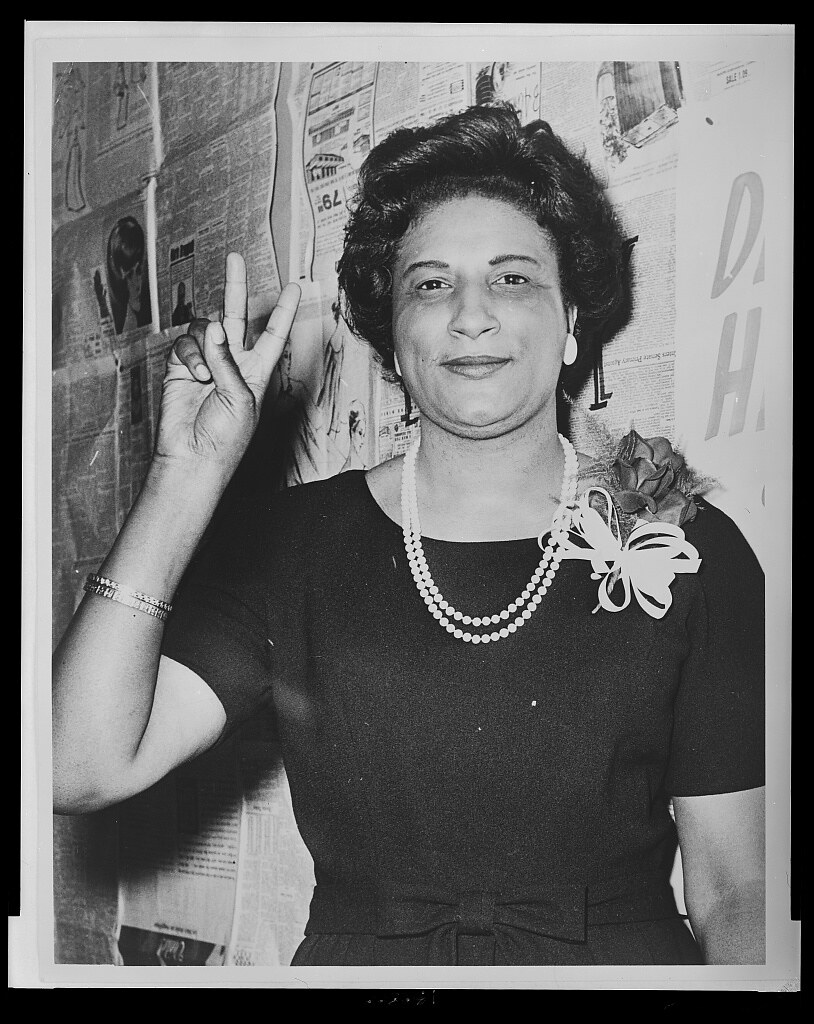Dorothy Height: The Only Woman Among the Big Six

Dorothy Height stood as the sole woman among the “Big Six” civil rights leaders, yet her contributions often get overshadowed by her male counterparts. As president of the National Council of Negro Women from 1957 to 1998, she organized the historic 1963 March on Washington while fighting a dual battle against both racial and gender discrimination. Height’s work extended far beyond protests – she developed programs that provided job training and educational opportunities for African American women across the country. Her influence was so significant that she advised every U.S. president from Eisenhower to Obama on civil rights matters. Despite being present at every major civil rights planning meeting, Height was often excluded from speaking at public events due to the sexism of the era.
Constance Baker Motley: The Legal Mind Behind Landmark Cases

Constance Baker Motley won 9 out of 10 civil rights cases she argued before the Supreme Court, including the landmark Brown v. Board of Education decision. As the first Black woman federal judge, she personally wrote the complaint that launched James Meredith’s integration of the University of Mississippi in 1962. Motley’s legal strategy became the blueprint for dismantling Jim Crow laws across the South, yet she received far less recognition than her male colleagues at the NAACP Legal Defense Fund. Her courtroom victories directly led to the desegregation of schools, transportation, and public accommodations in dozens of states. According to the Federal Judicial Center, Motley’s legal work affected more lives than perhaps any other civil rights attorney of her generation.
Pauli Murray: The Trailblazer Who Coined “Jane Crow”

Pauli Murray invented the term “Jane Crow” to describe the intersection of racial and gender discrimination, a concept that would later influence the development of intersectional feminism. As a lawyer, Murray co-founded the National Organization for Women (NOW) in 1966 and developed legal strategies that became foundational to both civil rights and women’s rights movements. Murray’s 1950 book “States’ Laws on Race and Color” was so comprehensive that Thurgood Marshall called it the “bible” for civil rights lawyers. She broke multiple barriers throughout her life, becoming the first Black person to earn a doctorate from Yale Law School and later the first Black woman ordained as an Episcopal priest. Murray’s legal theories about the 14th Amendment’s equal protection clause provided the framework for challenging both racial and gender discrimination in courts.
Fred Shuttlesworth: The Fearless Organizer of Birmingham

Fred Shuttlesworth survived multiple assassination attempts while leading the Birmingham campaign that became a turning point in the civil rights movement. His home was bombed twice, and he was beaten unconscious by a mob while trying to enroll his children in an all-white school, yet he never wavered in his commitment to direct action. Shuttlesworth co-founded the Southern Christian Leadership Conference with Martin Luther King Jr. and organized the protests that led to the iconic images of police dogs and fire hoses being used against peaceful demonstrators. His confrontational approach often put him at odds with more moderate leaders, but his tactics proved effective in forcing federal intervention. According to historian David Garrow, Shuttlesworth’s work in Birmingham was crucial in building public support for the Civil Rights Act of 1964.
Fannie Lou Hamer: The Mississippi Sharecropper Who Challenged the System

Fannie Lou Hamer’s powerful testimony at the 1964 Democratic National Convention exposed the brutal reality of voter suppression in Mississippi to a national television audience. Born into a sharecropping family, Hamer lost her job and faced violent threats after attempting to register to vote in 1962. Her famous declaration “I’m sick and tired of being sick and tired” became a rallying cry for voting rights activists across the South. Hamer co-founded the Mississippi Freedom Democratic Party, which challenged the all-white delegation to the 1964 Democratic Convention and helped pave the way for the Voting Rights Act of 1965. Despite facing poverty and violence, she registered thousands of Black voters and ran for Congress, becoming a symbol of grassroots political organizing.
Septima Clark: The Teacher Who Educated a Movement

Septima Clark developed the citizenship schools that taught reading, writing, and voting rights to thousands of African Americans across the South. Her educational programs trained over 10,000 community teachers who went on to establish schools in rural areas where formal education was limited or nonexistent. Clark’s work was so effective that Martin Luther King Jr. called her “the Mother of the Movement,” yet she was often excluded from major decision-making meetings due to gender bias. Her teaching methods emphasized practical skills like filling out voter registration forms and understanding constitutional rights. According to the Highlander Folk School archives, Clark’s citizenship schools were operating in 11 Southern states by 1965, directly contributing to the passage of the Voting Rights Act.
James Farmer: The Architect of Nonviolent Resistance

James Farmer founded the Congress of Racial Equality (CORE) in 1942 and pioneered the sit-in tactics that would become central to the civil rights movement. His organization conducted the first Freedom Rides in 1961, challenging segregation in interstate bus travel and leading to federal enforcement of desegregation orders. Farmer’s commitment to nonviolent direct action influenced an entire generation of civil rights activists, including the Student Nonviolent Coordinating Committee (SNCC). He spent time in prison for his activism and was beaten multiple times during protests, but his strategic use of media coverage helped build national support for civil rights. Research by the Civil Rights History Project shows that CORE’s methods were adopted by hundreds of local organizations across the country.
Diane Nash: The Young Strategist Behind Major Campaigns

Diane Nash was just 22 years old when she became the chief strategist for the Nashville sit-ins and later coordinated the Freedom Rides continuation after violence erupted in Alabama. Her leadership in the Student Nonviolent Coordinating Committee (SNCC) helped organize some of the movement’s most successful campaigns, including the desegregation of lunch counters in Nashville. Nash’s strategic thinking and organizational skills were crucial in planning the 1963 March on Washington and the Selma to Montgomery marches. She turned down the Presidential Medal of Freedom in 2022, stating that the honor should go to the grassroots activists who made the movement possible. According to SNCC archives, Nash’s work directly led to the desegregation of public accommodations in over 100 cities across the South.
C.T. Vivian: The Strategist of Direct Action

C.T. Vivian developed many of the nonviolent tactics that became standard practice in the civil rights movement, including the strategic use of jail time to overwhelm the system. As a close advisor to Martin Luther King Jr., Vivian trained thousands of activists in nonviolent resistance techniques through his work with the Southern Christian Leadership Conference. His confrontation with Sheriff Jim Clark in Selma was captured on film and helped build public support for voting rights legislation. Vivian founded the Vision organization in 1965, which provided leadership training for civil rights workers across the country. The King Center’s archives document that Vivian’s training programs were used by activists in over 30 states during the height of the movement.
Gloria Richardson: The Leader Who Brought Economic Justice to the Forefront

Gloria Richardson led the Cambridge Movement in Maryland, one of the first civil rights campaigns to focus explicitly on economic inequality and job discrimination. Her protests in the early 1960s forced the federal government to intervene and negotiate the first civil rights agreement to include economic provisions. Richardson’s approach differed from other civil rights leaders because she emphasized the need for economic power alongside legal equality. She organized boycotts of businesses that refused to hire Black workers and demanded job training programs as part of desegregation agreements. According to the Maryland State Archives, Richardson’s work in Cambridge became a model for economic justice campaigns in other cities, directly influencing the focus on economic rights in later civil rights legislation.
Robert F. Williams: The Advocate for Armed Self-Defense

Robert F. Williams challenged the nonviolent philosophy of mainstream civil rights leaders by advocating for armed self-defense against racist violence. As president of the Monroe, North Carolina NAACP chapter, Williams organized armed protection for civil rights workers and their families. His book “Negroes with Guns” influenced the Black Panther Party and other militant civil rights organizations of the late 1960s. Williams’ approach created controversy within the civil rights movement, but his ideas about self-defense resonated with many activists who faced constant threats of violence. FBI documents released in recent years show that Williams’ advocacy for armed self-defense was seen as so threatening that he was forced into exile in Cuba, where he continued broadcasting support for civil rights from abroad.
Daisy Bates: The Journalist Who Integrated Little Rock

Daisy Bates mentored and protected the Little Rock Nine as they integrated Central High School in 1957, facing down violent mobs and federal troops. As publisher of the Arkansas State Press, Bates used her newspaper to document civil rights violations and build support for integration efforts. Her home became a sanctuary for civil rights workers and a strategic planning center for desegregation campaigns throughout Arkansas. Bates’ leadership during the Little Rock crisis helped establish the federal government’s role in enforcing school desegregation orders. According to the Little Rock Central High School National Historic Site, Bates’ work extended far beyond the famous crisis, as she continued organizing voter registration drives and economic boycotts throughout the 1960s.




